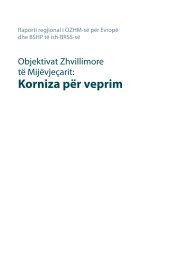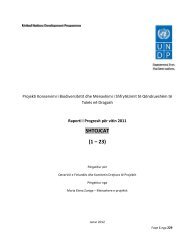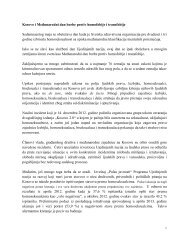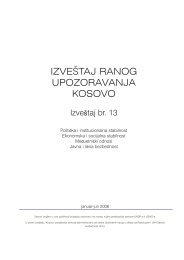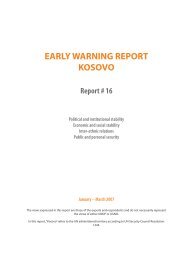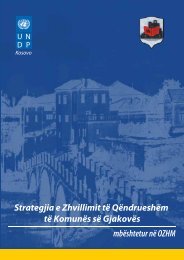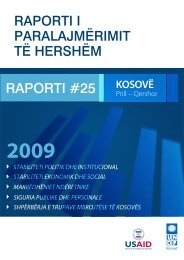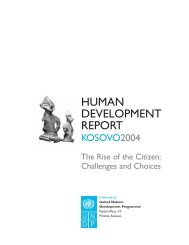Kosovo Human Development Report 2010 - UNDP Kosovo - United ...
Kosovo Human Development Report 2010 - UNDP Kosovo - United ...
Kosovo Human Development Report 2010 - UNDP Kosovo - United ...
Create successful ePaper yourself
Turn your PDF publications into a flip-book with our unique Google optimized e-Paper software.
CHAPTER 2<br />
Economic and labour market exclusion<br />
2.1<br />
Uneven economic<br />
development since<br />
1990<br />
The 1990s were a deeply challenging<br />
decade for <strong>Kosovo</strong>’s economy. During<br />
the build-up to the 1999 conflict,<br />
the economy deteriorated with the<br />
loss of export markets and collapse of<br />
many socially-owned enterprises. Massive<br />
disinvestment, poor economic<br />
policies, international sanctions and<br />
neglect of enterprises caused substantial<br />
deindustrialization. Mineral extraction,<br />
energy and agriculture - formerly<br />
key pillars of the <strong>Kosovo</strong> economy -<br />
significantly declined.<br />
After 1999, <strong>Kosovo</strong> made considerable<br />
progress towards economic<br />
recovery, with rapid growth typically<br />
found in the early years of post-conflict<br />
recovery and reconstruction. Economic<br />
policy reform and institution building<br />
helped the necessary adjustments<br />
towards a market economy. The international<br />
donor community played a<br />
positive role by successfully mobilizing<br />
and spending a total of 1.96 billion EUR<br />
for <strong>Kosovo</strong> between 1999 and 2003. 32<br />
<strong>Kosovo</strong>’s significant international presence<br />
has also reconfigured itself to support<br />
an EU accession process – both<br />
financially and with a high volume of<br />
mentoring and technical assistance.<br />
The EU alone provided over 1.0 billion<br />
EUR to <strong>Kosovo</strong> between 2000 and<br />
2006 through the CARDS programme<br />
(Community Assistance for Reconstruction,<br />
<strong>Development</strong> and Stabilisation)<br />
and over 426 million EUR under<br />
the Instrument for Pre-Accession Assistance<br />
(IPA) between 2007 and <strong>2010</strong>.<br />
High volumes of remittances were<br />
also transferred during the same period,<br />
becoming a surprisingly significant<br />
factor in recovery process. Remittances<br />
together with international<br />
aid paid for reconstruction of houses<br />
as well as for physical and social infrastructure<br />
(such as roads, schools and<br />
health centers). Remittance-related<br />
support was so widespread as to be<br />
almost universal. Out of those with<br />
family members abroad, 82 percent of<br />
<strong>Kosovo</strong>-Albanians received financial<br />
support – compared to only 14 percent<br />
of <strong>Kosovo</strong>-Serbs (see Table 2.1).<br />
Table<br />
2.1<br />
My family member(s) that live abroad support me<br />
financially<br />
Remittances and donor funding<br />
together contributed to a doubledigit<br />
annual growth rate in Gross Do-<br />
K-Albanian % K-Serb % Others %<br />
on a regular basis 30.4 1.3 14.9<br />
occasionally 51.5 12.3 41.8<br />
never 16.2 85.1 40.3<br />
DK/NA 1.9 1.3 3.0<br />
Total 100.0 100.0 100.0<br />
Source: <strong>UNDP</strong>, Early Warning <strong>Report</strong>s, January 2009<br />
ECONOMIC AND LABOUR MARKET EXCLUSION | 33



